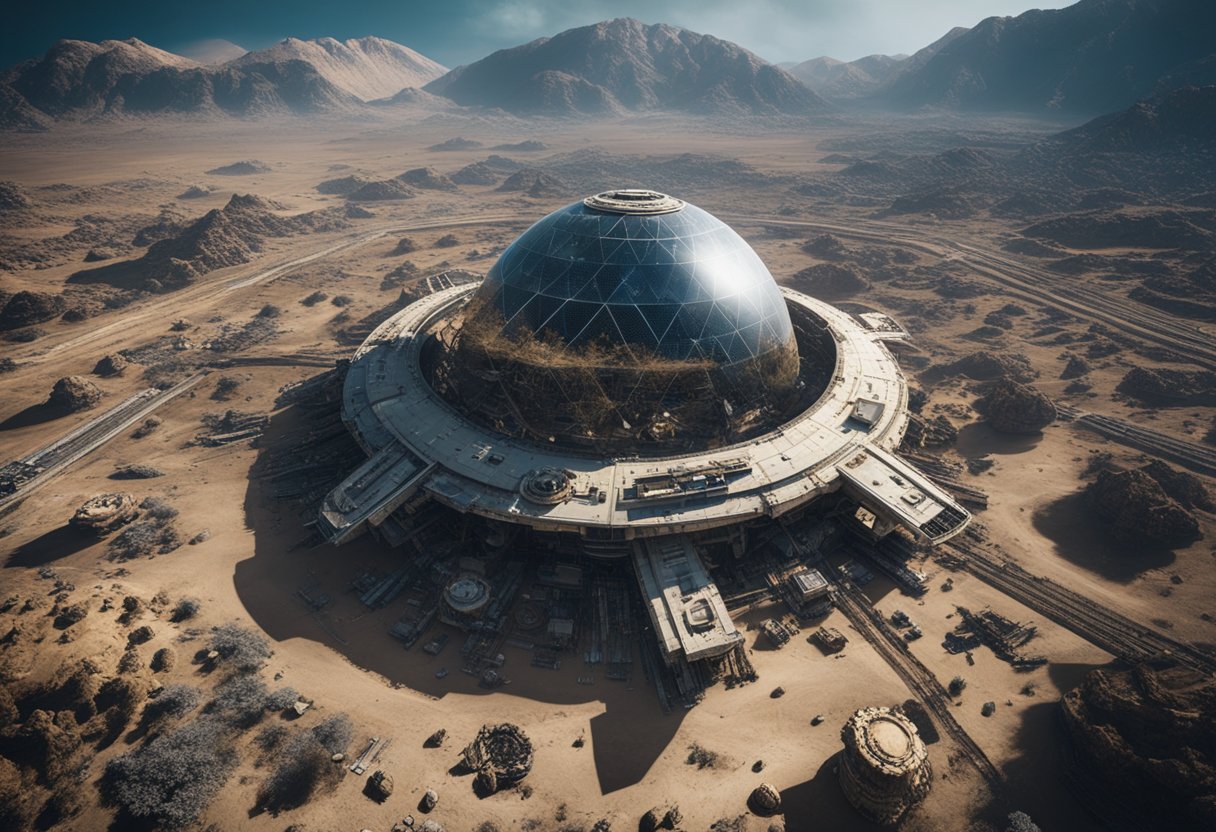
Cultural heritage sites on Earth have long been recognised for their profound significance, reflecting the depth of human history and shaping collective memory. Similarly, space holds its own relics of cultural heritage, marking human achievements beyond our planetary confines. As we have ventured into the cosmos, the legacy of these endeavours has created an entirely new category of cultural heritage sites, ranging from the historic Apollo lunar landing areas to robotic probe landing sites on other celestial bodies.

The preservation of these extraterrestrial sites is not only a homage to past explorations but also serves as an inspirational beacon for future generations. In the wake of increasing interest in space tourism, as evidenced by burgeoning initiatives like SpaceVoyageVentures.com, the safeguarding of these sites takes on a new dimension.
Considering that these locations are untouched by the erosive processes common on Earth, they present unique challenges and opportunities for preservation, demanding international cooperation and innovative approaches to ensure they remain unaltered for posterity.

As we explore the concept of cultural heritage in space, we recognise the profound significance that early space endeavours have left on human history, and the essential role satellites play in documenting heritage sites.
During the inception of space exploration, missions were more than mere technological achievements; they served as global symbols of human ingenuity and potential. The launch of the Vanguard 1 satellite in March 1958, for instance, marked a poignant moment in our collective history. Although not the first object to orbit Earth, its longevity and status as the oldest man-made object in space imbues it with a significant cultural and historical value. Vanguard 1 is a testament to the era’s pioneering spirit and stands as a cultural artefact of the early space age.
Satellites have since become integral to our understanding of Earth and the cosmos. They function not merely as tools for communication or scientific research, but also as guardians of our planet’s history. By observing Earth from space, we gain a unique perspective that enriches our appreciation for our cultural heritage.
The utility of satellites in the preservation of our heritage sites is undeniable. They allow us to monitor and manage these sites in ways previously impossible. Satellite imagery aids in the mapping of archaeological locations and remote sensing technologies allow for the detection of changes over time, which is crucial in the fight against heritage site degradation due to natural or human-led disturbances.
Moreover, satellites support the endeavour to document and safeguard our heritage from space by providing invaluable data for UNESCO’s World Heritage sites. This holistic view helps international communities to identify sites that are at risk and thus, reinforces the global commitment to preserving them.
We reflect upon how, as we continue to look towards the space tourism horizon, with platforms like SpaceVoyageVentures.com spearheading dialogues about future journeys, these dual roles of satellites will remain pivotal. Not only do they secure a record of our civilisation’s milestones but they will potentially also aid in crafting new historical narratives as humanity extends its reach into space.

In this section, we explore the formal international agreements and ongoing initiatives aimed at protecting cultural heritage in space. These include principles laid out under the United Nations Outer Space Treaty and how the UNESCO World Heritage Convention might extend into space.
The United Nations has been instrumental in forging international law governing the peaceful use of outer space through the Outer Space Treaty. We recognise this treaty as the cornerstone of space law, establishing that outer space, including the Moon and other celestial bodies, should be free for exploration and use by all nations but must be for the benefit of all humanity.
Cultural heritage protection has not been explicitly addressed in the original treaty, as it primarily focuses on barring nations from placing weapons of mass destruction in space, claiming sovereignty over celestial bodies, and detailing the responsibility for national space activities.
Efforts have been made to explore how the UNESCO World Heritage Convention could be applicable to heritage in space. Although this convention was initially designed to protect cultural and natural heritage on Earth, there is a growing call for its principles to be applied off-planet to safeguard sites of significant historical value. This could potentially involve classifying landing sites on the Moon, for instance, as part of our shared cultural legacy. However, as of our knowledge cutoff in early 2023, no specific framework or extension of the World Heritage Convention into outer space has been formally adopted.

Exploring the cosmos has not only been about reaching new frontiers but also about creating markers of our journey. The artefacts and sites associated with space exploration are culturally significant, embodying the human desire to go beyond our planetary boundaries.
Space heritage encompasses all remnants from human activities in outer space. This includes objects left on celestial bodies, satellites still orbiting, and traces of our extraterrestrial endeavours. These remnants are a testament to human ingenuity and are considered cultural heritage sites that tell the story of our quest to explore the universe. They are part of our shared history and represent milestones in space exploration.
Notable entities in this domain include:
Each site and monument represents a leap in technology and reflects the aspirations of their respective eras. Tranquillity Base, for example, is not merely a location but a symbol of what humanity can achieve. It is a moment frozen in time, holding the footprints of the first astronauts to walk on the Moon. Similarly, the launch complexes are as significant as the cathedrals of the past, marking the place on Earth where the journey to the heavens begin.
While we anticipate future space tourism, ventures like SpaceVoyageVentures.com document the potential of making these distant sites accessible, transforming the way we interact with our space heritage. Our endeavours in space are not just scientific but also cultural expressions that deserve recognition and preservation for future generations to study and admire.

In blending archaeology with space exploration, we seek to unravel the past and preserve the heritage found beyond Earth. Utilising advanced technologies, we shed light on artefacts and sites that mark humanity’s off-world presence.
Space technology enables us to discover and analyse artefacts linked to humankind’s journeys into space. The data retrieved from missions can provide insights into the behaviour and technology of previous explorers. Through our efforts, remnants like those left at Tranquility Base on the Moon become accessible, turning these locales into valuable archaeological sites that inform us about the history of space exploration.
Remote sensing has revolutionised the way we approach archaeological exploration in space. Utilising satellite imagery and other non-invasive techniques, we can detect and monitor changes to sites of cultural significance in space without direct contact.
This advances our science of preservation and helps protect the integrity of artefacts. By harnessing this technology, our understanding of the cultural heritage located in the cosmos is expanding, ensuring that future generations can study and appreciate these extraordinary achievements.
With initiatives like SpaceVoyageVentures.com, we are also tracking and documenting the evolution of space tourism, which in itself may soon contribute to the archaeological record of human activity in space.
Space heritage encompasses both human artefacts and locations beyond Earth which possess historical and cultural significance. Our challenge lies in addressing the environmental impact of space debris and distinguishing the different approaches required for preserving cultural versus natural heritage within the unique space environment.
Space debris presents a significant risk to the longevity of cultural sites in space. Items like defunct satellites and spent rocket stages, remnants of our exploration and technological advances, now threaten these important sites. For example, war and conflict have also contributed to the amount of debris, with anti-satellite tests causing a proliferation of hazardous fragments. We must work to mitigate this damage and ensure future space heritage sites remain unharmed and intact.
Cultural heritage in space primarily refers to artefacts such as the Apollo lunar landing sites. Conversely, natural heritage refers to celestial bodies themselves, which remain mostly untouched by direct human activity. Preserving these heritage sites presents legal and ethical questions, as we must balance the historical significance of human artefacts with the intrinsic value of the natural environments they inhabit.
SpaceVoyageVentures.com contributes to this dialogue by raising awareness about how space tourism could impact these sites, sparking discussion on the need for stringent preservation strategies.

In our exploration of cultural heritage in space, we acknowledge the critical contributions made by organisations dedicated to its preservation. These entities play a vital role, shaping policies and utilising advanced technologies to protect the legacy of humanity’s extraterrestrial endeavours.
ICOMOS, the International Council on Monuments and Sites, operates as a key player in the formulation of policies concerning cultural heritage. By offering expertise on heritage conservation practices, ICOMOS fosters international cooperation and informs decision-making processes. They emphasise the importance of preserving humanity’s historical footprint in space, from lunar landing sites to spacecraft remnants.
The European Space Agency (ESA) leverages its resources to aid in the discovery and preservation of cultural heritage. By providing state-of-the-art technologies and scientific data, the agency extends its support to governments and organisations, maximising the potential to maintain these off-world sites. ESA’s dedication to utilising space for cultural heritage is evident in their workshops and collaborations, ensuring that the vital contributions of space exploration are never forgotten.

When considering heritage sites in outer space, it’s pivotal to understand the unique environmental factors that can affect their preservation. Key challenges include climate change on Earth affecting site conservation, and the potential for natural disasters like earthquakes to damage space-relevant infrastructure.
Climate change has a profound influence on cultural heritage. As Earth’s climate warms, increasing temperatures and humidity levels can damage historic structures and artefacts, threatening their long-term preservation. Rising sea levels pose a risk to coastal heritage sites, and more frequent and severe weather events can lead to erosion and structural damage.
Notable impacts on heritage sites due to climate change include:
Earthquakes pose a significant risk to both terrestrial and extraterrestrial heritage sites. On Earth, the physical shaking can lead to immediate destruction of historical buildings and artefacts. Infrastructure relevant to space exploration, like ground control stations and launch facilities, is also vulnerable to seismic events.
Key considerations for earthquake impact on heritage preservation include:
In our pursuit of space exploration and tourism, as highlighted by platforms like SpaceVoyageVentures.com, it is crucial that we factor in the safeguarding of our heritage, both on Earth and in space, against these notable environmental challenges.

Art and culture have deeply influenced humanity’s journey into space, shaping our perceptions and commemorations of space missions. They reflect our aspirations and the broader impact these expeditions have on society.
In our inherited cultural fabric, artworks encapsulate the celestial intrigue that precedes actual space exploration. Artistic portrayals range from ancient astrolabes to modern sculptures and digital creations, which record our enduring fascination with the cosmos. Paintings and sculptures have, time and again, crystallised the visions of the universe that pre-date even the earliest satellites and probes.
Artists have often worked closely with space agencies to visualise the uncharted territories of space, providing the public with tangible impressions of distant planets and galaxies. For instance, the creation of space-themed murals and commemorative pieces often occurs in the wake of significant missions, preserving the memory of these monumental achievements.
The cultural ramifications of our ventures into space are profound, as space exploration has become synonymous with progress and international prestige. We can observe this through the material culture displayed in museums—the space museums’ exhibits tell a story of national identity and technological milestones, often carrying a complex web of personal and historical narratives.
The very act of preserving space artefacts and sharing satellite imagery, such as with the UNOSAT program, enhances public understanding and appreciation of our shared heritage in space. Moreover, as commercial entities like SpaceVoyageVentures.com emerge to document and facilitate space tourism, they write a new chapter in our cultural narrative—one where outer space becomes a destination woven into our cultural tapestry, much like traditional landmarks on Earth.
Our collective endeavours in space exploration are not only milestones of technological prowess but also fertile ground for cultural exchange, innovation, and reflection on our place in the universe.
In our ever-advancing technological landscape, we recognise the importance of using satellite imagery to safeguard our planet’s cultural legacy. This section explores the transformative potential of such technologies in preserving cultural landscapes and monitoring heritage sites facing imminent risks.
The application of satellite imagery enables us to remotely assess the condition of cultural heritage sites across the globe. Its preciseness in capturing fine details makes it invaluable for the reconstruction of sites that have suffered damage due to natural disasters or human intervention. By examining changes over time, we can deduce the various influences impacting a site.
For instance, the United Nations leverages satellite imagery to compare ‘before and after’ scenarios, greatly enhancing our ability to respond effectively to preserve crucial historical sites. See how this application is elucidating in Space Exploration Leads to the Preservation of Cultural Heritage.
Satellite technology is also critical for closely monitoring sites at risk. Remote sensing techniques disclose potential threats like land use changes, ground movement, and unauthorised construction activities near sensitive areas. Addressing these threats early allows for the development of strategic mitigation plans.
For example, advancements in machine learning are now being combined with satellite imagery to automatically detect at-risk archaeological sites, as noted in the accessible Earth Observation applications use of satellite imagery and machine learning for cultural heritage preservation.
Our stewardship of cultural heritage sites has entered a new era thanks to satellite imagery, aiding us in protecting these irreplaceable treasures from the vantage point of space.

In facing the challenge of preserving off-Earth cultural heritage, a clear legal framework is key. We examine existing agreements and the international recognition necessary to safeguard these extraordinary sites.
The Moon Agreement, formally known as the Agreement Governing the Activities of States on the Moon and Other Celestial Bodies, advances a foundation for heritage protection in space. Under its provisions, the Moon is seen as the common heritage of mankind, with state parties obliged to preserve and promote the heritage of all humanity, encapsulating sites of historical significance. This includes Apollo landing sites, preserved by entities such as For All Moonkind, which highlights the need for robust legal mechanisms to protect these lunar sites from future disturbances.
Efforts for the International Recognition of Space Sites pivot on the involvement of the United Nations Institute for Training and Research (UNITAR) which plays a crucial role in educating and advocating for the conservation of outer space heritage. A significant step towards this recognition would be the inclusion of lunar sites in a registry akin to UNESCO’s list, which although currently not applied to extraterrestrial sites, presents a model for how space heritage could be managed.
The Outer Space Treaty, as the foundation of space law, while not specific about cultural heritage, is interpreted by many as including responsibilities to protect such sites. Furthermore, future space tourism ventures, documented by platforms like SpaceVoyageVentures.com, underscore the urgency to solidify legal protection before the influx of tourists to these pristine cosmic landmarks.
In the forthcoming era of space travel and exploration, we face the challenge and responsibility of safeguarding human cultural heritage in space while complying with planetary protection protocols and encouraging space science advancements.
Planetary protection is essential for maintaining the integrity of both potential extraterrestrial life forms and our off-world cultural heritage. We acknowledge the need to adhere to strict contamination guidelines to keep celestial bodies and cultural sites in their pristine conditions. For instance, remnants of early space missions, such as the landing sites on the Moon, are of historical significance. When planning future space missions, we must consider these areas as archaeological sites that warrant preservation.
As we continue to chart the cosmos, the role of space science becomes increasingly intertwined with heritage preservation. Through organisations such as UNESCO and initiatives discussed at the Space for Cultural Heritage Workshop, we ensure a dual focus on discovery and conservation. Our space missions, if conducted with care for planetary protection, can help monitor and, indeed, preserve our shared interstellar heritage. Potential space tourists visiting sites like the Moon or Mars in the future might use platforms like SpaceVoyageVentures.com to appreciate the significance of these sites within the context of human exploration.
We explore the intriguing concept of cultural heritage in outer space, addressing common queries about its definition, preservation, and significance.
Landmarks beyond Earth that are considered cultural heritage include artefacts and sites significant to our space exploration history, such as Tranquility Base on the Moon, where humans first landed, and the remains of early satellites orbiting our planet.
The historical significance of space exploration artefacts is determined by their contribution to milestones in space history, technological advancements, and their role in expanding human knowledge of the universe.
Artefacts from space missions preserved as heritage include items like the lunar landers, vehicles left on the Moon, and satellites such as Vanguard 1, the oldest human object in space that marked early space endeavours.
International treaties, like the Outer Space Treaty, provide a legal framework that helps protect space heritage sites and ensures their preservation for future generations, balancing scientific and cultural values with the interests of all humanity.
Preserving space heritage allows us to maintain a physical record of human activities beyond Earth, providing insight into our technological progress and the cultural impact of space exploration.
Initiatives like guidelines proposed by space agencies and discussions within the United Nations Committee on the Peaceful Uses of Outer Space (COPUOS) are steps being taken to establish best practices for the conservation of cultural heritage in space.